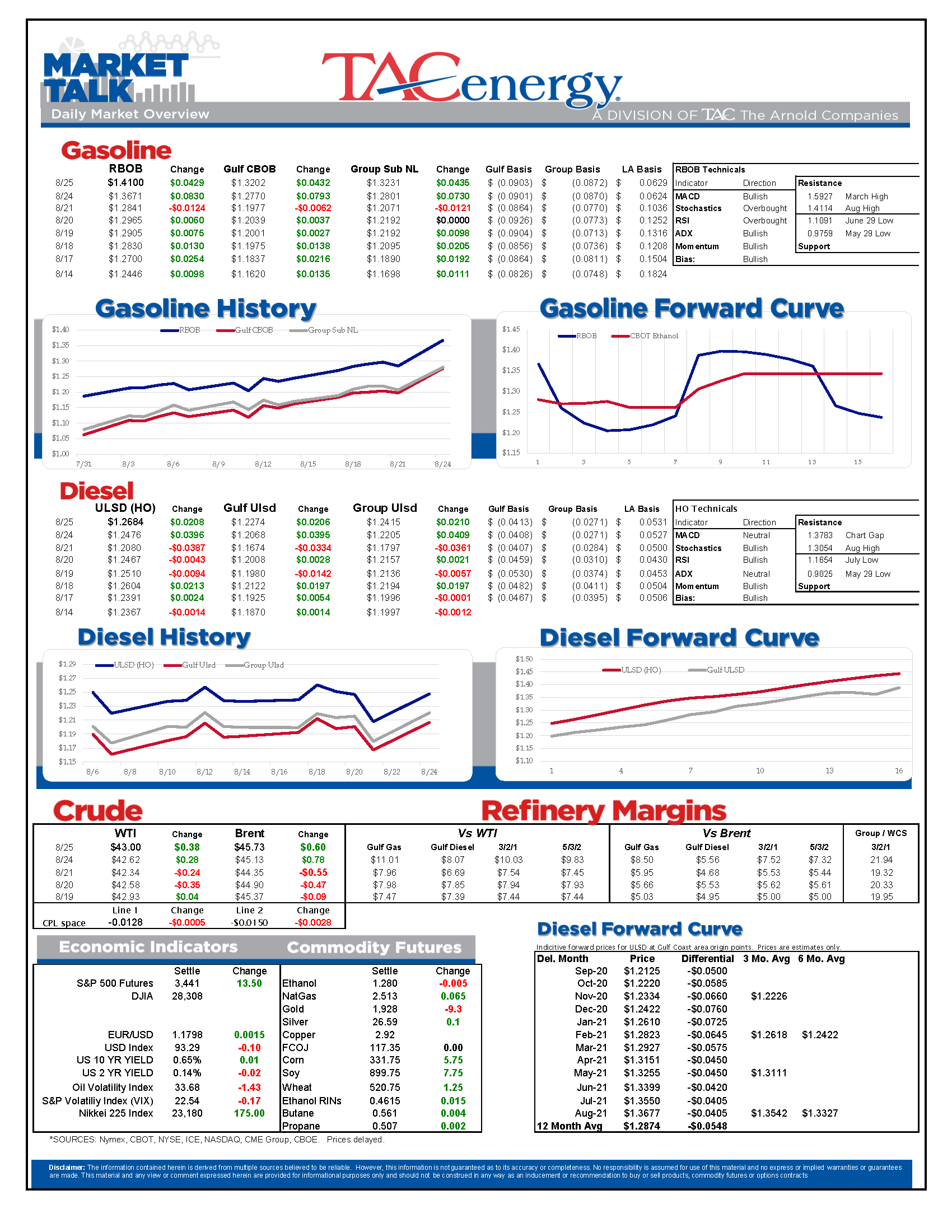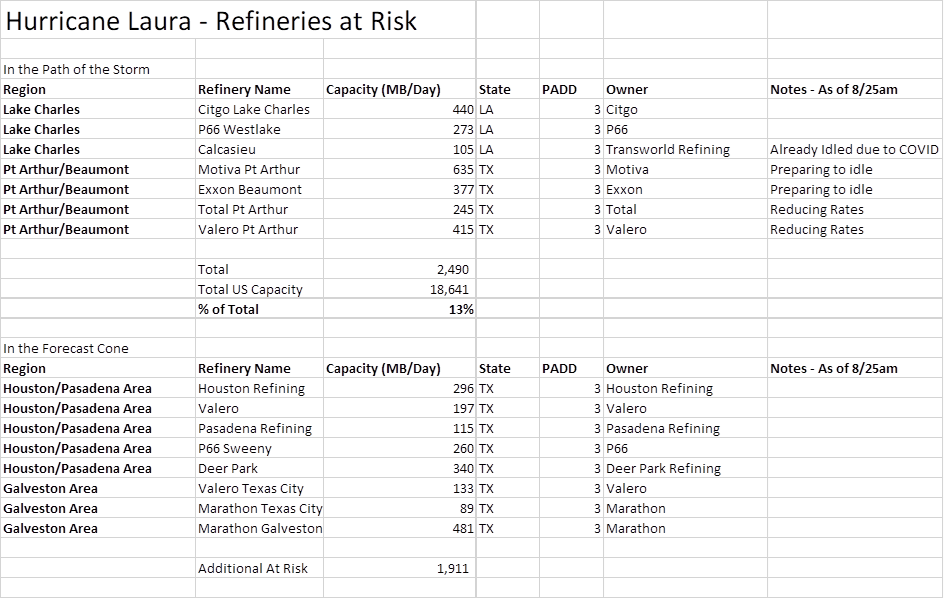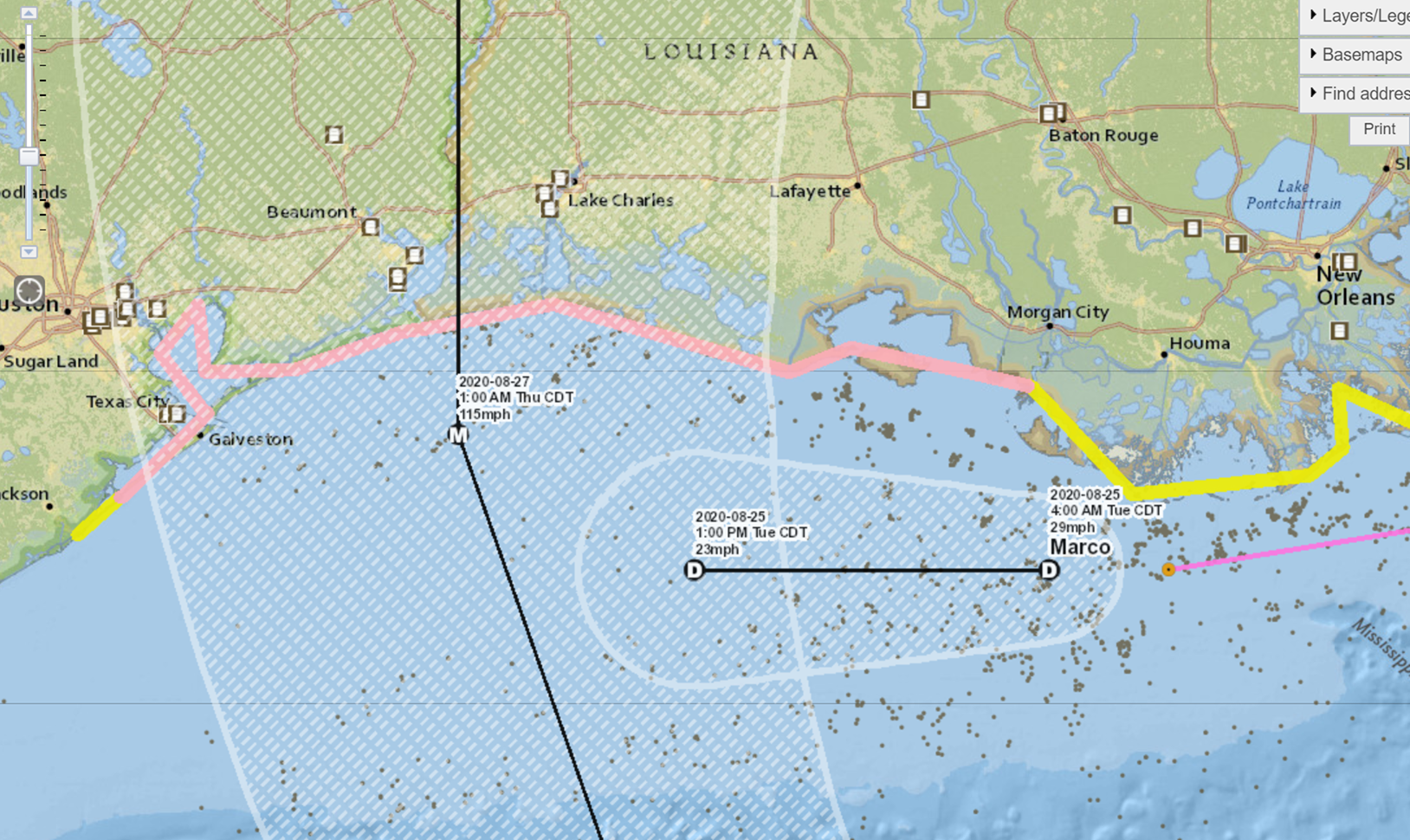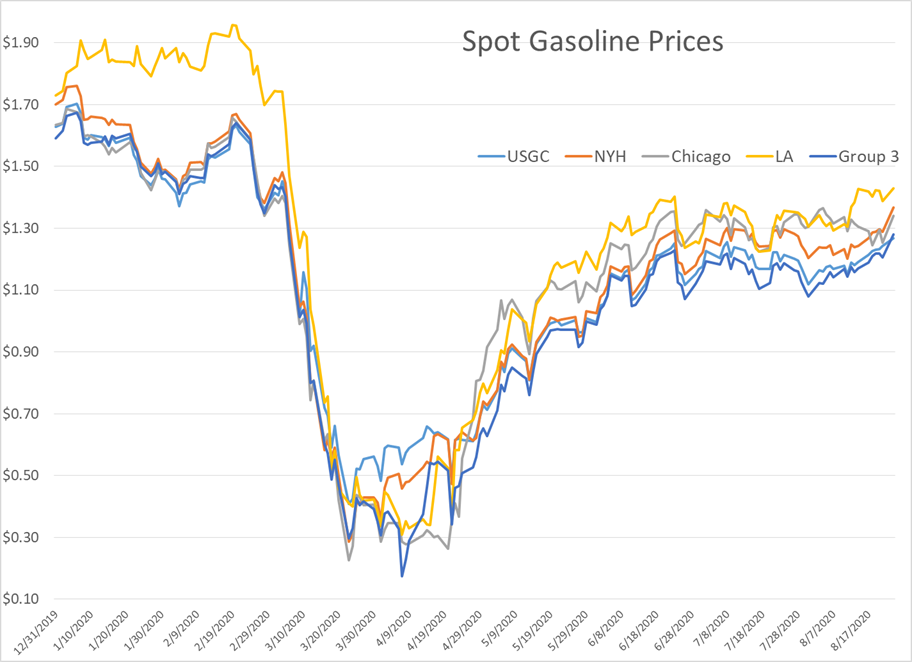Hurricane Laura Threatens U.S. Refineries

Gasoline prices are approaching six-month-highs as Hurricane Laura poses the biggest threat to U.S. refineries since Hurricane Harvey three years ago. Oil and diesel prices are moving higher as well, but are not keeping pace with gasoline – which is often the case in storm situations – and seem somewhat dubious about the long term impact this storm may have on an oversupplied market.
The Nasdaq and S&P 500 reached new record highs as trade and virus optimism kept the trend lines pointing higher, while the DJIA is undergoing a major overhaul. In the latest sign of the COVID market fallout, ExxonMobil is being removed from the DJIA, while Salesforce (dot com) will now be included.
While Marco fizzled out and spared Louisiana, Laura was upgraded to a Hurricane this morning, and 13 percent of the country’s refining capacity is in the direct path of the storm based on the latest models. The current forecasts have the storm coming on shore Thursday morning, as a category 3 “major” hurricane, just east of Port Arthur, TX. Plants in the Port Arthur/Beaumont hub have announced that they are reducing rates and/or idling units until the storm passes. The path of the storm could actually be just as troublesome, if not more, for plants around Lake Charles, LA, as they are on the more dangerous side of the storm, and could get a worse surge/flooding than the plants closer but on the west side. There is still a wide cone of uncertainty with this storm’s path, and even the Houston-area plants could still be impacted if the storm shifts further west.
Those plants that can continue operating are suddenly seeing their best margins in five months, a much needed relief for plants struggling to stay afloat financially. The economic hardship of refineries is one reason Laura’s impacts may not be as widespread as we might normally expect, since there’s at least one million barrels/day of capacity already idled due to weak demand, which should allow for some plants to increase rates and help offset the losses from others. In addition, many Gulf Coast refineries now rely on exports for nearly 20 percent of their production, so they will need to bring more product inland until ports can reopen.
That said, if the major pipelines in the region have to close due to power or flooding issues, then the potential for supply issues becomes more widespread in short order.
If Laura does make a significant impact, don’t be surprised to see states and the EPA ease RVP restrictions on gasoline, since we’re just weeks away from the annual transition anyway and pollution levels have already been at their lowest level in decades thanks to reduced consumption this year. You may notice that several spot markets aren’t keeping pace with the September futures contract this week, as they’ve already begun their fall transition to less-stringent gasoline specs.
Click here to download a PDF of today's TACenergy Market Talk.
Latest Posts
Energy Markets Rally Again Thursday After A Choppy Wednesday Session
Week 16 - US DOE Inventory Recap
Energy Markets Trading Quietly In The Red As Ethanol Prices Rally To Five-Month High
The Struggle For Renewable Producers Continues As A Rapid Influx Of Supply And Crashing Credit Prices Make Biodiesel
Social Media
News & Views
View All
Energy Markets Rally Again Thursday After A Choppy Wednesday Session
Energy markets are trying to rally again Thursday after a choppy Wednesday session. RBOB gasoline futures are leading the push higher, on pace for a 3rd consecutive day of gains after finding a temporary floor Tuesday and have added 12 cents from those lows.
Equity markets are pointing sharply lower after a weak Q1 GDP estimate which seems to have contributed to a pullback in product prices over the past few minutes, but don’t be surprised if the “bad news is good news” low interest rate junkies start jumping in later on.
The DOE’s weekly report showed sluggish demand for gasoline and diesel, but inventory levels in most markets continue to follow their typical seasonal trends. Refinery runs held fairly steady last week with crude inputs down slightly but total gross throughputs up slightly as most facilities are now back online from a busy spring maintenance season and geared up for peak demand this summer.
Propane and propylene exports spiked to a record high north of 2.3 million barrels/day last week, which demonstrates both the US’s growing influence on global product markets, and the steady shift towards “other” products besides traditional gasoline and diesel in the level of importance for refiners.
The EIA acknowledged this morning that its weak diesel consumption estimates reflected the switch to Renewable Diesel on the West Coast, although they did not provide any timeline for when that data will be included in the weekly survey. The agency acknowledged that more than 4% of the total US consumption is now a combination of RD and Biodiesel, and that number is expected to continue to grow this year. This morning’s note also suggested that weak manufacturing activity was to blame for the sluggish diesel demand across the US, while other reports suggest the freight recession continued through Q1 of this year, which is also contributing to the big shift from tight diesel markets to oversupplied in several regions.
Valero kicked off the Q1 earnings releases for refiners with solid net income of $1.2 billion that’s a far cry from the spectacular earnings north of $3 billion in the first quarter of 2023. The refining sector made $1.7 billion, down from $4.1 billion last year. That is a pattern that should be expected from other refiners as well as the industry returns to a more normal market after 2 unbelievable years. You wouldn’t guess it by looking at stock prices for refiners though, as they continue to trade near record highs despite the more modest earnings.
Another pattern we’re likely to see continue with other refiners is that Renewable earnings were down, despite a big increase in production as lower subsidies like RINs and LCFS credit values sting producers that rely on those to compete with traditional products. Valero’s SAF conversion project at its Diamond Green joint venture is progressing ahead of schedule and will give the company optionality to flip between RD and SAF depending on how the economics of those two products shakes out this year. Valero also shows part of why refiners continue to disappear in California, with operating expenses for its West Coast segment nearly 2X that of the other regions it operates in.

Week 16 - US DOE Inventory Recap

Energy Markets Trading Quietly In The Red As Ethanol Prices Rally To Five-Month High
Energy markets are trading quietly in the red to start Wednesday’s session after a healthy bounce Tuesday afternoon suggested the Israel-Iran-linked liquidation had finally run its course.
There are reports of more Ukrainian strikes on Russian energy assets overnight, but the sources are sketchy so far, and the market doesn’t seem to be reacting as if this is legitimate news.
Ethanol prices have rallied to a 5-month high this week as corn and other grain prices have rallied after the latest crop progress update highlighted risks to farmers this year, lower grain export expectations from Ukraine, and the approval of E15 blends this summer despite the fact it pollutes more. The rally in grain and renewables prices has also helped RIN values find a bid after it looked like they were about to test their 4-year lows last week.
The API reported small changes in refined product inventories last week, with gasoline stocks down about 600,000, while distillates were up 724,000. Crude oil inventories increased by 3.2 million barrels according to the industry-group estimates. The DOE’s weekly report is due out at its normal time this morning.
Total reported another upset at its Port Arthur refinery that’s been a frequent flier on the TCEQ alerts since the January deep freeze knocked it offline and damaged multiple operating units. This latest upset seems minor as the un-named unit impacted was returned to normal operations in under an hour. Gulf Coast basis markets have shrugged off most reports of refinery upsets this year as the region remains well supplied, and it’s unlikely we’ll see any impact from this news.
California conversely reacted in a big way to reports of an upset at Chevron’s El Segundo refinery outside of LA, with CARBOB basis values jumping by more than a dime. Energy News Today continued to show its value by reporting the upset before the flaring notice was even reported to area regulators, proving once again it’s ahead of the curve on refinery-related events. Another industry news outlet meanwhile struggled just to remember where the country’s largest diesel seller is located.
Click here to download a PDF of today's TACenergy Market Talk





